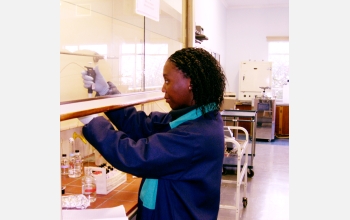Multimedia Gallery
Biogeochemical Educational Experiences-South Africa (Image 11)
Hlolohelo Chalale, a geology major from Witswatersrand University, South Africa, extracts microbial membrane lipids from biofilm samples taken from a South African gold mine. The samples were taken by participants of the University of Tennessee's (UT) Biogeochemical Educational Experiences - South Africa (BEE-SA), a Research Experiences for Undergraduates (REU) program. South African mines, particularly the deep gold mines, have been selected for study because they provide relatively easy access to deep fissure waters and the rocks that host them. Since these mines are some of the deepest excavations in the world, they increase the possibility of uncontaminated studies of earlier evolution. [Image 11 of 11 related images. See Image 1.]
More about this image
Supported by the National Science Foundation's (NSF) REU program and by UT, BEE-SA brings together U.S. and South African students and faculty mentors to examine microbial lifeforms that exist in the deepest mines in the world. The international host institution is the University of Free State (UFS) in Bloemfontein, South Africa.
Students participating in BEE-SA work side-by-side with South African students under the joint supervision of U.S. and South African faculty while conducting interdisciplinary research on biogeochemical processes in South African gold mines. As part of the research program, students present their research results during laboratory progress meetings, at a science symposium held at the conclusion of the REU activity, and in written manuscript format as a final report. During their REU tenure, students have the opportunity to explore scientific, educational and technical collaborations as well as career development. Topics of research include the characterization of microbial communities with molecular and biochemical techniques; utilization of geochemical and isotopic parameters to constrain nutrient cycling in groundwater; investigating extreme enzymes--proteomics; and examining functional genes.
BEE-SA is an outgrowth of NSF-funded research including workshops supported by NSF's Life in Extreme Environments Program (LExEn), managed by Princeton University. The goal of the Princeton LExEn project is to study biochemical approaches for gold extraction at depths beyond the limit of human mining, utilizing mesophilic sulfide oxidizing and Fe (II) oxidizing bacteria prior to cyanidation. (Year of image: 2003)
Credit: Photograph by Susan Pfiffner, University of Tennessee, Knoxville
Images and other media in the National Science Foundation Multimedia Gallery are available for use in print and electronic material by NSF employees, members of the media, university staff, teachers and the general public. All media in the gallery are intended for personal, educational and nonprofit/non-commercial use only.
Images credited to the National Science Foundation, a federal agency, are in the public domain. The images were created by employees of the United States Government as part of their official duties or prepared by contractors as "works for hire" for NSF. You may freely use NSF-credited images and, at your discretion, credit NSF with a "Courtesy: National Science Foundation" notation.
Additional information about general usage can be found in Conditions.
Also Available:
Download the high-resolution JPG version of the image. (1.3 MB)
Use your mouse to right-click (Mac users may need to Ctrl-click) the link above and choose the option that will save the file or target to your computer.

